ETH's strong rebound drives the Ethereum pledge track to heat up, and the top agreement accelerates market recovery

Reprinted from panewslab
05/12/2025·21DAuthor: Nancy, PANews
In recent days, Ethereum has strongly pulled out a big positive line, causing the morale of the "E Guard" to rise sharply, and the market's bullish sentiment has quickly heated up. This strong pull-up not only brought about a comprehensive recovery of the Ethereum ecosystem, but also further heated up the market's expectations for the pledge function of Ethereum spot ETFs, especially related pledge projects have become a hot spot for capital pursuit.
Ethereum rebounds strongly, and ETF staking expectations drive confidence
back up
Recently, Ethereum has experienced a strong rebound for many consecutive days, with its total market value surpassing Alibaba in one fell swoop and ranking 39th in the global asset market value. Related topics of soaring popularity have also topped the Douyin hot list and become the focus of hot discussion in the market.
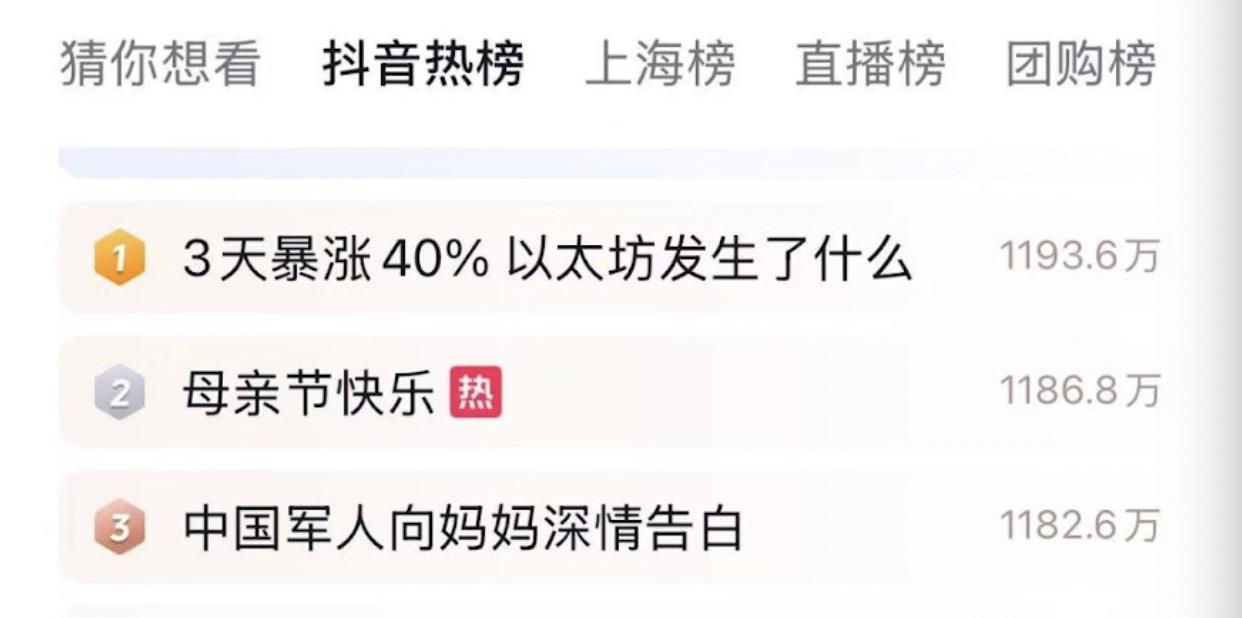
According to CoinGecko data, as of May 12, Ethereum price rose to US$2,521, a record high in the past two months, with an increase of 40.4% in the past seven days, and its market value soared by more than US$87.58 billion in a single week. At the same time, Coinglass data shows that as of press time, Ethereum's monthly return so far in May has reached 39.53%, not only setting the strongest single-month increase since 2025, but also significantly surpassing the median increase (18.43%) and average increase (31.15%) in May of all years. This strong rebound not only ended the downward trend of Ethereum for three consecutive months, but also became a phased turning point for the significant recovery of market sentiment, showing a simultaneous recovery of capital and investment confidence.
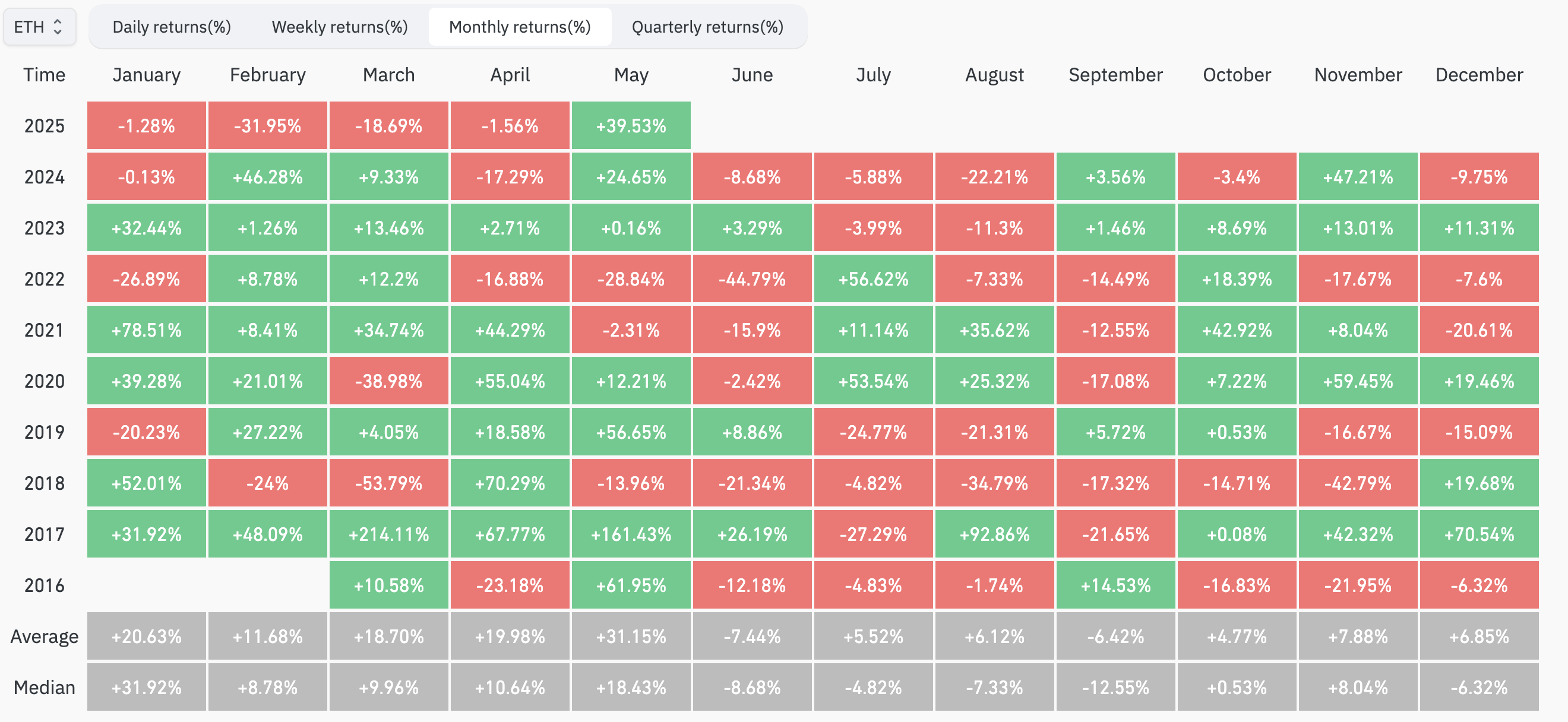
The on-chain funding trends have also further verified this trend. Artemis data shows that in the past seven days, the Ethereum ecosystem has attracted as much as US$1.2 billion inflows, ranking first among all blockchains. Among them, the net inflow funds exceeded US$490 million, far ahead of other mainstream public chains.
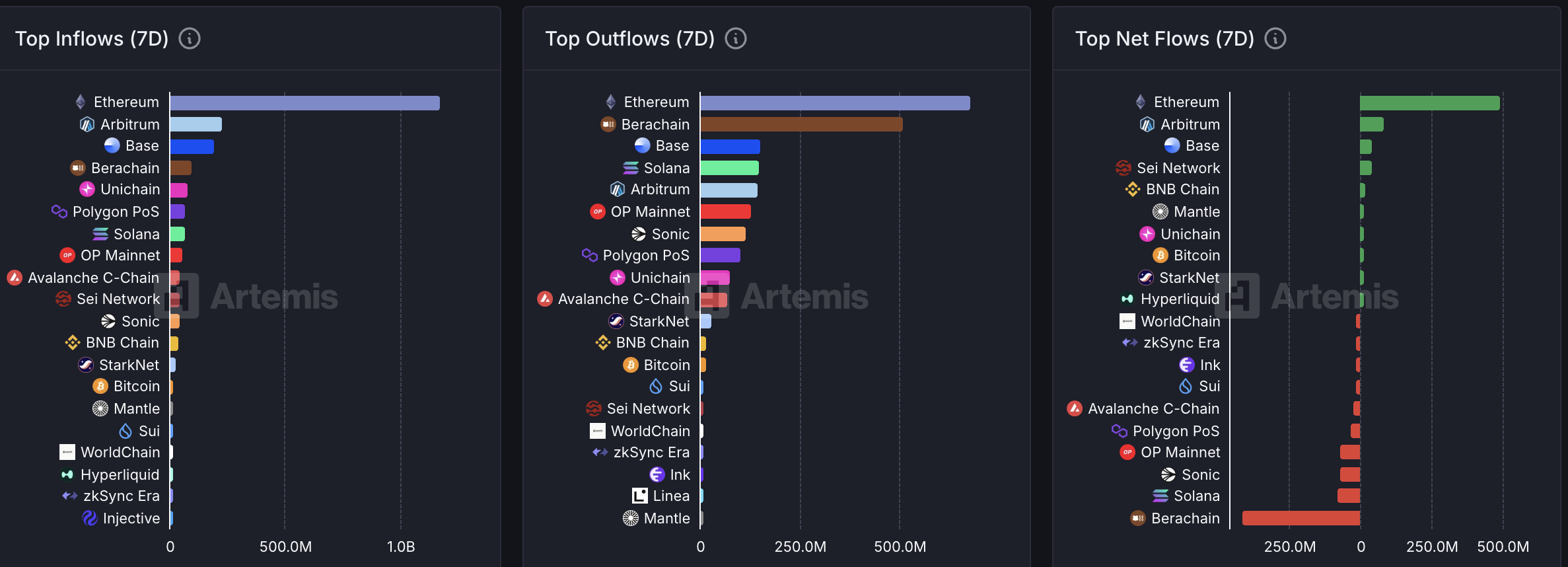
The rebound is considered to be caused by the resonance of multiple factors, including marginal improvement in macroeconomic policies, the previous price repair of excessive bearish sentiment, the imminent upgrade of Ethereum Pectra, the continued expansion of the actual narrative, and the positive expectations of pledge of Ethereum spot ETFs.
Among them, the ETF pledge function is expected to become one of the important catalysts. Over the past few months, several institutions have actively sought to obtain SEC approval to allow the introduction of staking mechanisms in crypto ETF products. Although the SEC has recently postponed the approval of applications for Fidelity and Grayscale, related discussions are accelerating.
At the end of April this year, Grayscale met with the US SEC Cryptomatic Working Group in Washington, DC to discuss the changes in the staking regulation of Ethereum ETP, saying that the total assets managed by US Ethereum ETP reached US$8.1 billion, but due to the inability to participate in the staking, it lost about US$61 million in profits from its launch to February 2025. The agency pointed out that the introduction of a staking mechanism will help improve Ethereum network security while bringing additional returns to shareholders.
Another asset management giant, BlackRock, also recently met with the SEC Crypto Working Group, covering issues such as crypto asset supervision, ETF pledges and option products. The document shows that the meeting discussed “considerations for promoting staking ETP” and discussed parameters for determining the option positions and exercise limits of encrypted ETFs, as well as specific criteria for approving encrypted ETFs. Among them, Robert Mitchnick, head of BlackRock digital assets who attended the meeting, said in March that if Ethereum spot ETFs can add to the staking function, although there are some "complex challenges" to solve, pledge returns are an important way to obtain investment returns in this field, which may become a "leap turning point" for Ethereum.
It is worth noting that Hong Kong regulators have taken the lead in encrypting the issue of ETF pledge. In April this year, the Hong Kong Securities Regulatory Commission (SFC) issued new guidelines, allowing licensed virtual asset trading platforms (VATPs) to provide pledge services to customers. At the same time, virtual asset funds (such as Ethereum spot ETFs) can participate in on-chain pledge activities under the prudent regulatory framework, and subsequently approved two Ethereum spot ETF products with pledge functions.
The positive progress of these ETF staking effectively boosted Ethereum market expectations and further accelerated the confidence repair process.
The pledge track has heated up sharply, and the top projects TVL and coin
prices have flew together
The Ethereum pledge track has also become one of the key directions for capital and narrative focus. DeFiLlama data shows that as of May 12, TVL on the Ethereum pledged track rebounded to US$34.11 billion, achieving a 60.3% increase in the past month. At the same time, TVL, which is re-private, has also risen to nearly US$12.85 billion, an increase of 54.8% in the past 30 days.
This article PANews has taken stock of the latest market trends and market performance of the five leading pledge projects in the Ethereum ecosystem, and has made breakthroughs in technological progress, governance mechanisms and ecological construction, promoting the recovery of the overall market. Both TVL and token prices have achieved double-digit growth.
Lido: TVL soars to nearly $23 billion, driven by technology and
governance
Lido is the largest liquidity staking agreement. DeFiLlama data shows that as of May 12, Lido's TVL was about US$22.93 billion, an increase of up to 57.5% in the past month. At the same time, Coingecko data shows that its native token LDO also rose by about 48.6% during the same period.
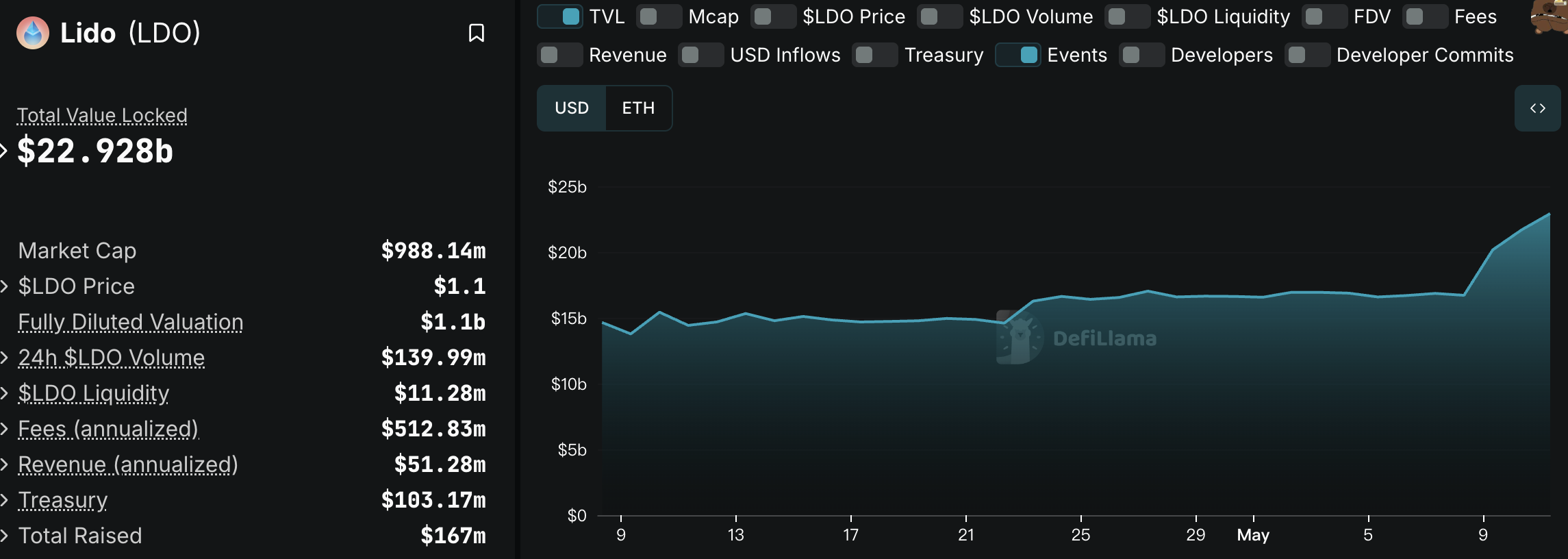
Lido has made progress in governance and technology in recent months. In April, Lido DAO launched a number of governance votes, including Snapshot votes and Aragon main stage votes, involving agreement updates and decision-making. In the same month, Lido also launched the V3 test network, where developers can use Lido stVaults on the Hoodi Ethereum test network to create customized staking solutions. Lido stVault is a modular primitive that allows stakers, node operators and protocols to customize staking solutions based on their own needs. Users can customize the fee structure, verify settings, optimize risk/reward structure, etc. while retaining the advantages of stETH. Not long ago, Lido announced the upcoming launch of a “dual governance” mechanism, a dynamic time-locking mechanism that allows stETH holders to quit Lido on Ethereum in the face of a controversial Lido DAO governance motion.
It is worth mentioning that although the recent concern has attracted attention due to the suspected leakage of Chorus One's oracle private key, Lido DAO has launched an emergency proposal as soon as possible, and the pledged users have not been affected, and the agreement is still safe and functioning normally. At the same time, since the Lido oracle system adopts a multi-signal mechanism of 9-choice 5, a single oracle failure will not threaten the system, and the rest of the nodes are not affected.
EigenLayer: Multi-line advancement helps coin price and TVL fly together
EigenLayer continues to be the leader in the re-pled track. DeFiLlama data shows that as of May 12, EigenLayer's TVL reached US$11.36 billion, an increase of about 52% in the past month. Meanwhile, Coingecko data shows that its native token EIGEN rose 69.7% during the same period.
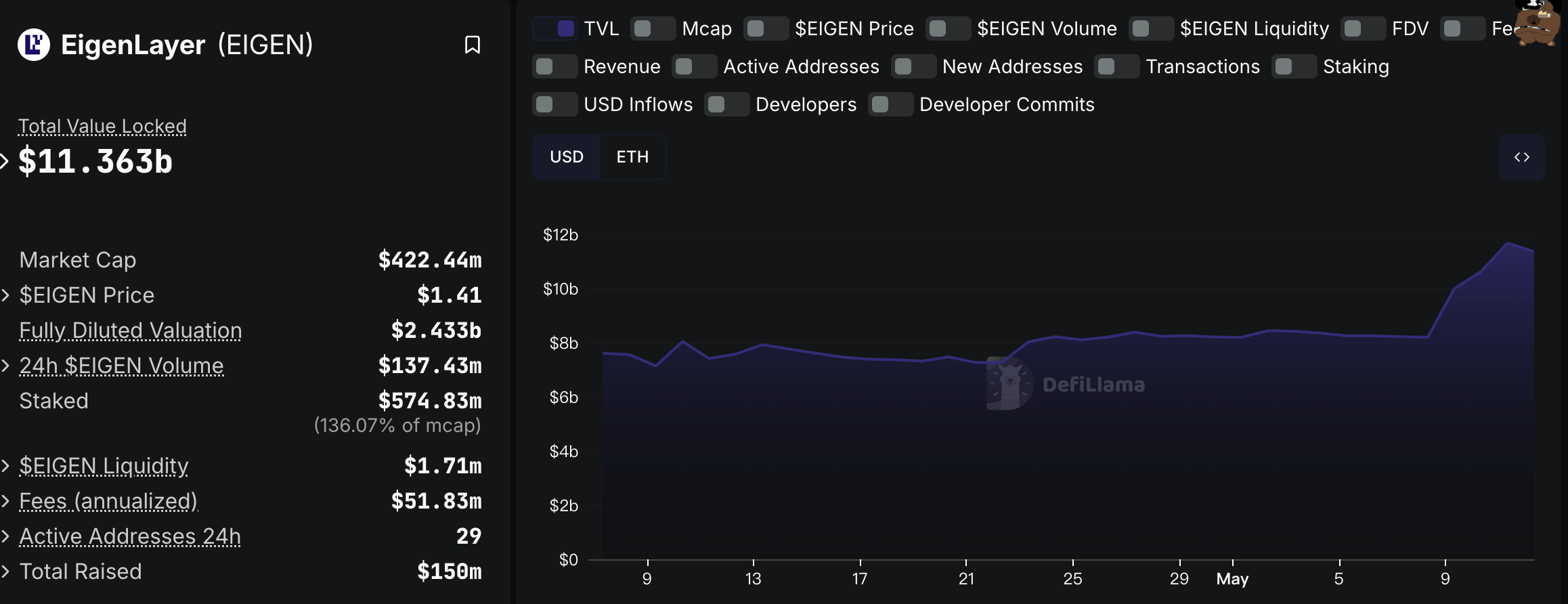
In the past two months, EigenLayer has continued to promote technology upgrades, developer ecology and application expansion. In mid-April, EigenLayer's Slashing (punishment mechanism) was officially launched on the main network. After the upgrade, operators and stakeholders using the EigenPod CLI need to undergo checkpoint upgrades. At the same time, each application verification service (AVS) can now directly implement punishment conditions on the main network. Not long after, EigenLayer announced that it will launch the Redistration function soon, bringing new capabilities to its Slashing upgrade. This feature allows decentralized verification services (AVS) to redistribute funds after pledged funds are penalized rather than directly destroyed, thus supporting more complex use cases such as lending and insurance agreements. The first batch of non-ETH assets (such as LSTs, EIGEN, USDC and AVS tokens) are supported. ETH is not yet within the scope of support and is planned to be launched on the Ethereum main network in June. In recent days, EigenLayer announced that it has participated in the May 7 Ethereum Pectra upgrade to support Ethereum network improvements, and plans to introduce new features such as verifier integration for EigenPods, as well as announcing the plans to hold the "Berlin Hacker Village" in Berlin, thereby attracting developers around the world to build the next generation of verifiable applications.
Rocket Pool: From node incentives to ecological integration, it will
drive the same increase in TVL and coin prices
Rocket Pool is also one of the highly-watched Ethereum staking protocols. According to DeFiLlama data, Rocket Pool's TVL reached US$1.74 billion, up about 56.3% in the past month. Meanwhile, Coingecko data showed that its native token RPL rose by about 67.5% during the same period.
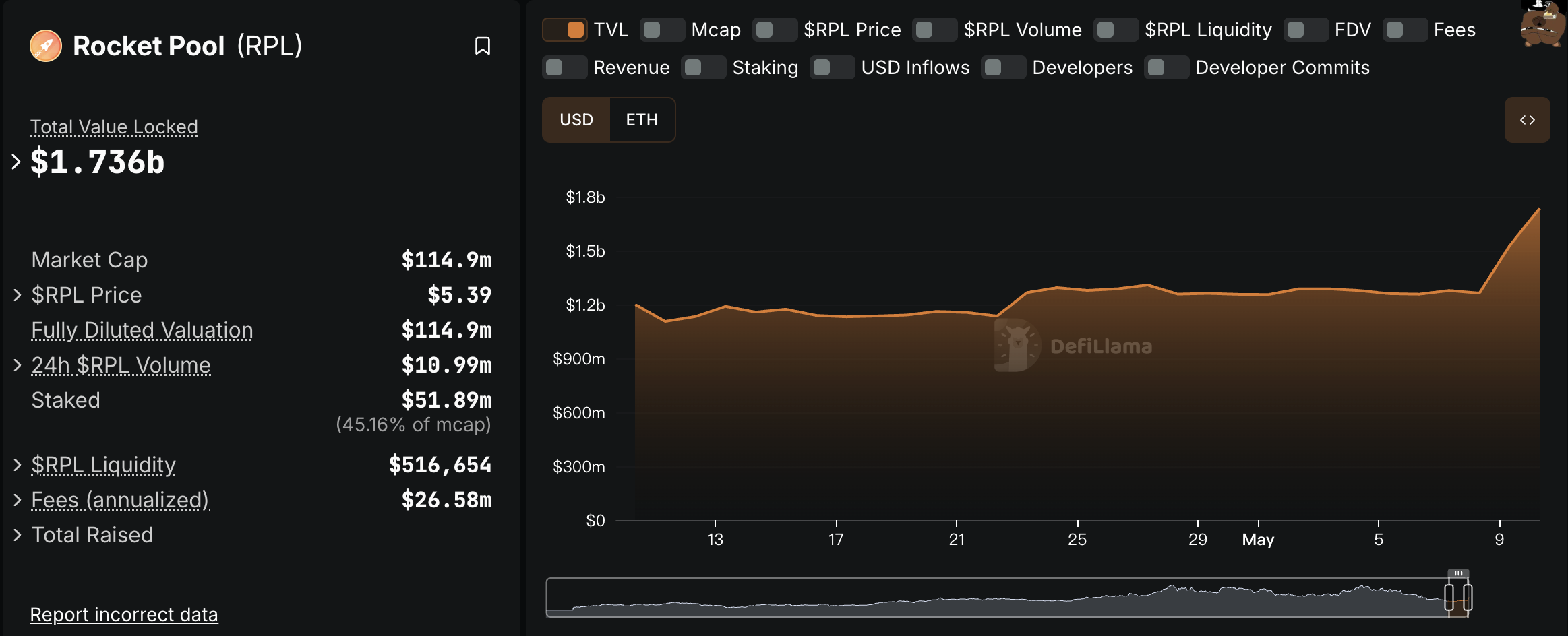
In the past two months, Rocket Pool has mainly focused on technology upgrades, community governance and DeFi ecosystem expansion. For example, in March, Rocket Pool announced the distribution of 133 ETH to node operators, and emphasized that the pool was free to join and had no usage fees to attract more participants; in April, Rocket Pool released a Smart Node update and held a community call to discuss whether DAO should raise funds through bridging fees and share quarterly product development roadmap updates, as well as promote the integration of rETH in the DeFi protocol, etc. In May, Rocket Pool actively promoted node software updates to support Pectra upgrades and launches.
Symbiotic: TVL breaks through $1 billion and receives tens of millions
of dollars in financing
The restaking protocol Symbiotic mainly emphasizes modular security and capital efficiency. DeFiLlama data shows that Symbiotic's TVL has exceeded US$1.09 billion, up about 45% in the past month.

Symbioticfi has continued to advance its universal restaking agreement over the past two months and has made positive progress in financing in the near future. In April, Symbiotic announced the completion of a $29 million Series A financing, with participation from institutions such as Paradigm, CyberFund, Pantera Capital and Coinbase Venture. In the same month, ether.fi announced the launch of a $40 million crypto venture capital fund, with Symbiotic being one of its first investment projects.
SSV Network: The monthly price increase of coin exceeds 90%, and the
active verifiers exceed 100,000
According to the official website, as of May 12, SSV Network's TVL had exceeded US$8.9 billion, and the number of ETH pledges was close to 3.467 million. Coingecko data shows that its token SSV has risen by as much as 91.6% in the past month.

Recently, SSV Network announced that it had exceeded 100,000 active validators, accounting for about one-tenth of Ethereum validators. This tweet was forwarded by Lido, Renzo, Kraken, ChainLayer, HashKey Cloud, Nansen, Swell and Eigenpie. At the same time, SSV Network announced on May 6 that the SSV 2.0 test network was launched in Hoodi, aiming to significantly improve the security of the Ethereum ecosystem by introducing the concept of "application-based" (bApps), while reducing the security costs of developers by up to 90%, and providing risk-free benefits to validators, thereby unlocking more value for the entire ecosystem.


 chaincatcher
chaincatcher